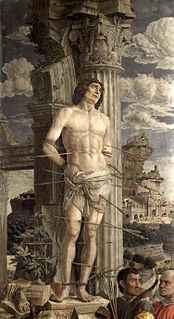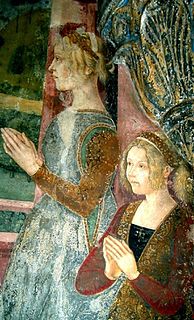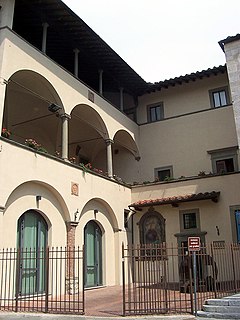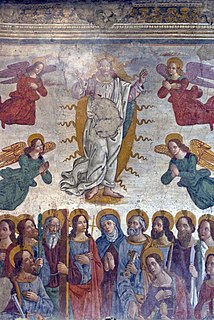

The Master of Pratovecchio (active between about 1435 and 1455) was an Italian painter of the Renaissance, named by Roberto Longhi in a 1952 article on the basis of stylistic similarities of a number of works to an altarpiece painted for the monastery of San Giovanni Evangelista in Pratovecchio. The centre panel of the triptych, depicting the Assumption of the Virgin is currently on deposit in Arrezo; the left and right side-panels are in the National Gallery, London.

Italy, officially the Italian Republic, is a country in Southern Europe. Located in the middle of the Mediterranean Sea, Italy shares open land borders with France, Switzerland, Austria, Slovenia and the enclaved microstates San Marino and Vatican City, as well as a maritime border with Croatia. Italy covers an area of 301,340 km2 (116,350 sq mi) and has a largely temperate seasonal and Mediterranean climate. With around 61 million inhabitants, it is the fourth-most populous EU member state and the most populous country in Southern Europe.
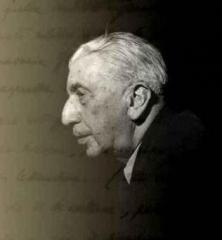
Roberto Longhi was an Italian academic, art historian and curator. The main subjects of his studies were the painters Caravaggio and Piero della Francesca.
Other works attributed to the artist include Three Archangels in the Gemäldegalerie, Berlin, a Madonna and Child in the Fogg Art Museum, Cambridge, Massachusetts, another Madonna and Child in the Pinacoteca di Brera, Milan and a Madonna with six angels, in the Pierpont Morgan Library & Museum, New York.

The Gemäldegalerie is an art museum in Berlin, Germany, and the museum where the main selection of paintings belonging to the Berlin State Museums is displayed. It holds one of the world's leading collections of European paintings from the 13th to the 18th centuries. Its collection includes masterpieces from such artists as Albrecht Dürer, Lucas Cranach, Hans Holbein, Rogier van der Weyden, Jan van Eyck, Raphael, Botticelli, Titian, Caravaggio, Giambattista Pittoni, Peter Paul Rubens, David Teniers the Younger, Rembrandt, Johannes Vermeer, and Antonio Viviani. It was first opened in 1830, and the current building was completed in 1998. It is located in the Kulturforum museum district west of Potsdamer Platz.

The Pinacoteca di Brera is the main public gallery for paintings in Milan, Italy. It contains one of the foremost collections of Italian paintings, an outgrowth of the cultural program of the Brera Academy, which shares the site in the Palazzo Brera.

The Morgan Library & Museum – formerly the Pierpont Morgan Library – is a museum and research library located at 225 Madison Avenue at East 36th Street in the Murray Hill neighborhood of Manhattan, New York City. It was founded to house the private library of J. P. Morgan in 1906, which included manuscripts and printed books, some of them in rare bindings, as well as his collection of prints and drawings. The library was designed by Charles McKim of the firm of McKim, Mead and White and cost $1.2 million. It was made a public institution in 1924 by J. P. Morgan's son John Pierpont Morgan, Jr., in accordance with his father's will.
The Master's works are considered to be strongly influenced by the painters Domenico Veneziano and Andrea del Castagno, but also the sculptor Donatello.

Domenico Veneziano was an Italian painter of the early Renaissance, active mostly in Perugia and Tuscany.

Andrea del Castagno was an Italian painter from Florence, influenced chiefly by Masaccio and Giotto di Bondone. His works include frescoes in Sant'Apollonia in Florence and the painted equestrian monument of Niccolò da Tolentino (1456) in the Cathedral in Florence. He in turn influenced the Ferrarese school of Cosmè Tura, Francesco del Cossa and Ercole de' Roberti.

Donato di Niccolò di Betto Bardi, better known as Donatello, was an Italian sculptor of the Renaissance. Born in Florence, he studied classical sculpture and used this to develop a complete Renaissance style in sculpture, whose periods in Rome, Padua and Siena introduced to other parts of Italy a long and productive career. He worked with stone, bronze, wood, clay, stucco and wax, and had several assistants, with four perhaps being a typical number. Though his best-known works were mostly statues in the round, he developed a new, very shallow, type of bas-relief for small works, and a good deal of his output was larger architectural reliefs.
In 1974 a painting then in the Getty collection attributed to the Master of Pratovecchio (subsequently sold in 2011), [1] depicting a Madonna and Child with Saint Bridget and the Archangel Michael, was linked by Burton B. Fredricksen to a painting similarly to have included the Archangel Michael and Saint Bridget, commissioned in 1439 for the Bridgetine convent at Pian di Ripoli, for which payment was made to a Giovanni di Francesco del Cervelliera da Rovezzano. However, due to marked differences in style between the works attributed to the Master of Pratovecchio and those attributed for Giovanni di Francesco later in the 1450s, it has been suggested that despite the payment, the work was not created by Giovanni di Francesco, but only later, by another. [1]
Giovanni di Francesco del Cervelliera or Giovanni di Francesco was an Italian painter, active in Florence in the mid-fifteenth century.
Another name, suggested by Padoa Rizzo in 1993, is Jacopo di Antonio (1427-1454), a cousin of Giovanni di Francesco. However, the only work previously associated with him is of a different style again, attributed by some instead to Pesellino or a close follower. [1] Writing in 2005 Andrea De Marchi therefore considered the identifications so far presented to be "not at all satisfactory". [2]
